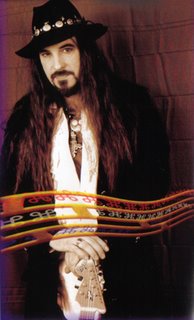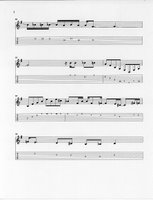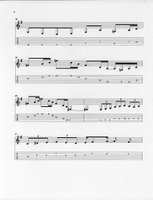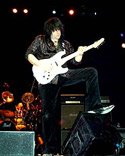 James Byrd is my all time favourite guitarist simple as that. However, to many he is criminally unknown except for those that may have heard Yngwie Malmsteen mention his name in interviews (Yes a player Malmsteen has praised). To find out about Byrd's career in detail I suggest you read our write up on him here, for those wishing to get straight to the interview then an opening paragraph from that profile should tell you everything you need to know - Byrd has one of the purest tones you will hear and his entire catalogue screams quality and is essential listening. His guitar work showcases what the instrument is capable of in the right hands with his immense note choice, clean speed picking, superb vibrato and original phrasing - Byrd is "a players player" and anyone that takes the time to investigate his music further will be blown away – (a baroque and roll.com guarantee) - simply if you have yet to check out any of Byrd's work then get on over to Guitar9.com via the following links and purchase any of these albums.
James Byrd is my all time favourite guitarist simple as that. However, to many he is criminally unknown except for those that may have heard Yngwie Malmsteen mention his name in interviews (Yes a player Malmsteen has praised). To find out about Byrd's career in detail I suggest you read our write up on him here, for those wishing to get straight to the interview then an opening paragraph from that profile should tell you everything you need to know - Byrd has one of the purest tones you will hear and his entire catalogue screams quality and is essential listening. His guitar work showcases what the instrument is capable of in the right hands with his immense note choice, clean speed picking, superb vibrato and original phrasing - Byrd is "a players player" and anyone that takes the time to investigate his music further will be blown away – (a baroque and roll.com guarantee) - simply if you have yet to check out any of Byrd's work then get on over to Guitar9.com via the following links and purchase any of these albums.
Now on with the interview.
James many thanks for participating in this interview with Baroque & Roll.
JB: Thank you
If we can start bang up-to date and talk about your recently formed company Byrd ™ Guitars (
http://www.byrdguitars.com). Can you give us some background into why you started your own guitar company, especially given the major endorsement deals you have had in the past?
JB: It really didn’t start out that way. I mean, I wasn’t intent on creating a company. It all started one day with my frustration with my Strat’s ergonomics and in particular, a cut I got on my right hand from a pickguard screw which had gone rusty and presented a miniature razor from the chrome plate lifting. I was actually recording solos for Crimes of Virtuosity when it happened, and I realized there was actually blood smeared on the pickguard. Pretty rock and roll really, but at the times, I was really pissed about it. The studio can be a frustrating place sometimes, so I’m sure that added to it. Later that day I was looking at my Strat and wondering why it was the way it was. I mean I knew the history of Fender very well, so it was rhetorical. All of a had a sudden realization that of all people, I was actually in a very good position to design my own guitar, and to finally have exactly what I’d always wanted.

The Super Avianti ® really is a beautiful guitar to look at, yet is quite unique as well, what led to the body design and headstock design?
JB: I’ve been associated with two instruments in my professional career; the Gibson Flying V ®, and the Fender Stratocaster ®. There were things I liked about both guitars, but I’d settled on the Fender ® as being closest to giving me everything. Two things I didn’t like about the Fender ® though, were the lower body horn, and the headstock. The lower body horn was put there for people who find sitting with the guitar over their right leg, and not playing above the 10th fret to be among their priorities, and although I liked the looks of the headstock, I knew it was actually backwards from an engineering perspective; it’s design raised the string tension on the highest strings dramatically. The only thing I really liked about the Flying V ® were it’s lack of a body horn, and it seemed to have some interesting acoustical properties as well. I didn’t like the humbucking pickups or the controls and fixed bridge, and it was also not well balanced on the strap. Now these were all things I already knew, but really, the guitar’s design just came rushing to me in one drawing; I took the basic ‘V’ shape, and added length to the lower wing while shortening the upper wing to put the center of gravity below the centerline and to make the right arm position better, and I designed the headstock with the four higher strings (D through E) in a left handed configuration to re-balance the string tension and eliminate the need for string trees.
There was really a lot more than that to it, but that was the initial concept. I also decided that while I was at it, I’d try inlaying the pickguard assembly into the face of the guitar to make it smoother, going back to my original cut hand as inspiration. Obviously I also decided to use better designed screws that were truly flush and wouldn’t rust. When I finally had the first guitar in hand, I thought is played and sounded brilliantly. The man who’d helped me build the first guitar is a guy named Lynn Ellsworth, founder of Boogie Body ™ guitars. He was something of a saint to me, and when we assembled the first guitar, he really thought I was onto something and said so. It was then that I sort of fell into the whole thing in a way I hadn’t intended, thinking that my guitar had real potential for everyone of a particular playing bent. All refinements of the design took place between 14 prototypes, each one slightly more evolved than the previous. The headstock was enlarged because it gave a better sound, the contours on the body were refined from one to the next, and experiments with routing ended up creating a large tone chamber. The neck joint went through 4 different versions; the first being like a Strat ® with the metal plate and four screws, then a square neck heel with a contour and four screws, then an extended sculpted 5 bolt neck joint, and finally, a slightly less extended contoured neck heel with four bolts. It was all a lot of time spent evaluating comfort and performance.
Obviously this site is aimed at neo-classical metal fans and being a pioneer of the style why would you recommend the Super Avianti® to anyone looking into potentially buying a new instrument?
JB: If you love a great Strat ® sound, plus additional pickup combinations (it has seven), plus some really fat sounds all it’s own, and more comfort from a performance based design, this might be your holy grail. It has it’s priorities, first and foremost being able to get around on the fret board unimpeded. Playing in the upper neck areas is a joy, and even shifting your hand to play sweep arpeggios at the 14th fret is easy on account of the complete access to the last fret. So if you value the notion of nothing interfering with anywhere you want to go on the neck, this is for you. But if you’re someone who insists on sitting down with the guitar over your right leg to play, you’re going to have an argument right away because that was not the priority in the design. This was never my concern because when I sit down to play, I play in the classical position with the guitar between my legs. The Super Avianti ® is the most comfortable guitar I’ve ever played sitting down, and because of the body’s shape, I can actually take both hands of the instrument, and it just stays there. It’s also designed to stay in tune during radical tremolo abuse without a locking tremolo system. Because of my headstock design, these things truly stay in tune when you use the trem.
The custom scalloped neck work you do is again unique, what led to this design and did you have a similar scallop on your previous Strats/ESP’s?
JB: My endorsement guitars has ordinary scalloping if I requested the companies to scallop the necks, but the guitars I did myself, I scalloped in what I thought was a better way; removing wood exactly where your fingers are placed, as opposed to directly in the middle of the fingerboard.
Tonally what can this guitar do that you were unable to do with other guitars?
JB: Because of the scale length (25.5) and pickups (single coil sized noiseless DiMarzio ® Virtual ® pickups ), the basic tonality is very much like a Strat. But it has more sustain, and a fuller bottom end to the sound because of the body size and shape, and the tone chambering. Because of the 2 additional pickup combinations I added over the standard 5-way set-up, I can turn on the neck pick and bridge pickup together, or all three pickups at once. I also put the tone controls on the neck and the bridge instead of the neck and the middle. As a result, I can get all the Stratty sounds, plus Gibson ® like fatness, and with all 3 pickups on, it gets a hollowish tone very similar to Brian May’s tone on ‘Bohemian Rhapsody’. It’s just really versatile, playable, and as I said, it stays in tune like a rock. Before I designed these guitars, all my guitars had Floyd Rose ® locking tremolos on them. Now none of my guitars have them. The sound is much better without the Floyd Rose ®.
Music, you have been quiet since the release of the stunning ‘Byrd – Anthem’ back in 2002, can we expect any new music in the near future?
JB: Yes, but I’m sorry to say that I’m not immersed in anything recording-wise at the moment. I went through a lot of really difficult times between a spinal injury I suffered in 2001, the artistic difficulties of 9-11, and the death of my Father in 2004, just a bunch of negative stuff. So I’ve been taking a break from composing and recording because I just don’t feel like dealing with certain emotions for a while. The short answer is when I feel ready to pour my heart into it, and right now, I don’t.
 Going back to ‘Anthem’, that release is in my top 3 all time favorites and still a couple of hundred listens on inspires and speaks to me. Yet it’s quite advanced from your earlier works such as Atlantis Rising or The Apocalypse Chime. How do you view that album now looking back?
Going back to ‘Anthem’, that release is in my top 3 all time favorites and still a couple of hundred listens on inspires and speaks to me. Yet it’s quite advanced from your earlier works such as Atlantis Rising or The Apocalypse Chime. How do you view that album now looking back?
JB: Honestly, I can’t even listen to it. Making that album was actually nothing short of hellish. I was on so many narcotics for pain from my back injury, it was just a bad trip. It was physically painful to even sit with the guitar, and it took forever to record because the narcotics really effected my short term memory badly. If I left off on something for more than a day, I’d have to re-learn things, and the pain I was in made it very difficult to spend more than 45 minutes at a time sitting in the studio (I was actually in a wheel chair some of the time, and laid out on in bed the rest of the time for several months). They had me on dilaudid morphine and phentynol, a drug supposedly 10 times more powerful than heroin. I’d glad someone likes the album because I just have this association with physical pain, 9-11 anxiety and frustration with the recording album that almost makes me sick to listen to it today.
Compositionally it’s immense and your guitar work is the icing on the cake to many degrees. Was the material written with guitar in mind foremost and did you approach for that album differ radically from your previous works?
JB: Everything was composed apart from the guitar. I think the pain that holding the guitar created probably made that decision easy to make, but yes, the guitar was intended to be entirely supported as opposed to being the support. I composed everything on the keyboard, and that too added a lot to the frustration of making the album because I’m not a keyboard player; I’d have the lines in my head (what there was of it anyway!), and then have to learn them on the keyboards. I recorded all the orchestration as single lines. If you hear 30 violins and cellos, it was 30 single note recordings of each sample. Plus I was doing some of the engineering by myself. Try keeping track of that when you’re drugged into numb oblivion (don’t). But the good thing is, I’ve learned I’d make a lousy drug addict. I hate the way that stuff made me feel, the way they affected me, and although it took me months to taper off all the medications because of the physical addiction, I’m not someone who’s ever going to end up hooked on narcotics. I’d rather stick pins in my eyes than be on them again.
You have a large back catalogue of material. What album gave you the most headaches from start to finish and does that in anyway detract from your attachment to the album?
JB: Well I think I’ve answered that one haven’t I.
 Your growth as a musician is quite clear to anyone that listens to your back catalogue. But how do you feel you have grown as a musician/artist over your career?
Your growth as a musician is quite clear to anyone that listens to your back catalogue. But how do you feel you have grown as a musician/artist over your career?
JB: I wish I could answer that, I really do. It’s one of the things I’m trying to figure out right now. I’ve “grown” to the point of being sick of even hearing my own music. That’s the truth. I’m so self-critical, I’ve criticized myself right out of wanting to make an album at the moment. You know I’ve changed directions within my direction so many times, and it’s really because my relationship with music is a love-hate affair. Once I’ve gone in a particular direction, I’m just always dissatisfied and feel like there must be something “more”. I know it’s actually a liability commercially because people naturally want the second album they purchase from an artist, to have some bearing on the previous one. And a lot of people do that, in fact most try to do that. Well, I did that one time with Anthem, deliberately picking up on where I’d left off conceptually with Flying Beyond the 9, and it’s hard to be objective on account of the other factors, but now I’m just tired of the whole approach right now. I’m trying to figure out what’s left within what I consider my musical parameters. I don’t really care for progressive Jazz, but honestly, I’m just kind of at the point where I wish there were more than 12 notes to work with, you know? I’ve got so many different approaches to music in me, many of them things I’ve never recorded (like big-band stuff, traditional blues and rockabilly) but making an album requires a certain unification of focus. That’s why I’m taking a break, that and the other reasons I mentioned. Obviously commercial considerations have little to do with what I’ve been about musically or I’d never have bothered to make the albums I make. Sometimes you just have to question everything and stew for a while, and that’s where I am right now.
Over the last few years you have also appeared on a few tribute albums, your working of Uli Jon Roth’s ‘Still So Many Lives Away’ stood out a million miles from any other on the Uli tribute, what do you try to do when doing a cover version?
JB: You really think so? That’s nice of you to say. I didn’t see the point in playing Uli’s solo note for note. If someone really wanted to hear that, well, they can just listen to the original. And Uli played a truly brilliant solo in my opinion. I’ve never seen the point of becoming a human tape recorder on these tribute albums. That’s what most guys do I know, but my feeling is why do it at all if you’re going to do that. I just tried to take the vibe, and work within what I considered it’s wider intent, with my own choice of notes. To maybe play something in the same spirit, but not the same notes.
You recently contributed to a Frank Marino tribute; can you tell the readers how that came about?
JB: I’ve known Frank for ten years now, and before we became friends, I was a huge fan of him growing up. Frank introduced me to the guy who runs his website (http://www.mahoganyrush.com) because I was needing some help with my first website. His name is Willy Parsons, otherwise known as “Wild Willy” (http://www.wildwilly.com/) . He’s actually a stand-up comedian in LA and right now he’s in the finals of “The last comic standing” on NBC (http://www.nbc.com/Last_Comic_Standing) . Willy is really responsible for bringing Frank Marino back into the public eye through his web site. Anyway, over the years of knowing Willy, at some point we started discussing the idea of doing a tribute album for Frank. Willy found a financial backer in LA who put up the production money, and I helped Willy decide who we’d try to get on the album.
 Getting back to guitar you have the finest vibrato out there and alter it to suit the mood, how long did it take for you to realise you had a unique vibrato – often seen as the players fingerprint.
Getting back to guitar you have the finest vibrato out there and alter it to suit the mood, how long did it take for you to realise you had a unique vibrato – often seen as the players fingerprint.
JB: It was actually hearing a player who had a brilliant vibrato that made me nearly obsessive about developing my own. This goes back a very long way, probably further than most people know, but it was hearing Paul Kossoff of Free that first spun my head. I was in awe of his vibrato. I had it nailed by the time I was 15, and from there, it was a matter of realizing that there were several other vibratos that could be studied and eventually made into a lexicon. Robin Trower was another one, but his was almost the same as Paul Kossoff’s. Hendrix also had a remarkable vibrato at times, and I loved his slow-hand vibrato on the studio side of ‘Voodoo ‘Chile’. The of course there was Blackmore. And then Micheal Schenker. Let’s just say, that I was a connoisseur of the subject. I eventually came to regard different approaches to vibrato, the same way I regarded modes or even notes; why just use the same one all the time? Of course there were other things which came into the mix like using the tremolo. And there’s also length-wise classical vibrato which I use all the time too. That has a whole different sound to it because you’re not only going above the pitch, but below it as well. And sometimes I actually combine using the vibrato arm, and lengthwise classical hand vibrato at the same time. It's extremely tricky to do, but it has a wholly unique sound to it. That’s what I did on the intro to “Goodbye my Love” (Crimes of Virtuosity) along with the volume swells.
Your use of speed is also more selective than many other players in the neo-classical genre, what do you aim for when it comes to solo time?
JB: It really isn’t a conscious thing, it just evolves as I familiarize myself with the music.
What is your most challenging lead break recorded to date?
JB: That’s really hard to answer because when I first record them, they’re all challenging. The only way to answer that is to think in terms of having to go back and exactly play them note for note. Some of them are more structured than others, so it’s easier to go back and know exactly what I was doing. But some of those structures are physically insane (see TAB examples below, MIDIFILE: http://www.geocities.com/strat110/solo1.mid) .

Going Home solo tab p.1 [click to englarge]
 Going Home solo tab p.2 [click to englarge]
Going Home solo tab p.2 [click to englarge] Going Home solo tab p.3 [click to englarge]
Going Home solo tab p.3 [click to englarge]
 Going Home solo tab p.4 [click to englarge]
Going Home solo tab p.4 [click to englarge]

Going Home solo tab p.5 [click to englarge]I see you also recently launched your own myspace page. What do you think of the myspace phenomena and can you see it going the same way as the original mp3.com?JB: I think it’s hilarious! I mean really, think about it. What IS it? It’s a lot like a bunch of people congregating in some empty field for no reason. Why am I there? Because everyone else is there. I can’t even remember how I got there! It doesn’t really do anything. It’s just a social cluster-fuck. It’s a bunch of people all standing in the same place, and I don’t think a single one of them could tell you why they’re there other than the fact that everyone else is also there. Maybe it’s like some guy on a sidewalk who decides to stand there and look up and point, you know? Pretty soon there’s a crowd all standing there looking up and pointing at the sky. People are strange and have a herd mentality. As to any comparison to MP3, I don’t know. People are also opportunists, so I’m sure that eventually someone’s going to try to make more money out of it for the shareholders. I guess the bottom line is that it’s a nice place to put pictures and music for now, but like MP3, I wouldn’t ever pay for the privilege if the owners get greedy. I’m just there because it’s there, and it allows me to engage in shameless self-promotion free of bandwidth charge. Does anyone really need a better reason than that?
http://www.myspace.com/guitaristjamesbyrd
James Byrd Links
Now check out some of Byrd's work!


















